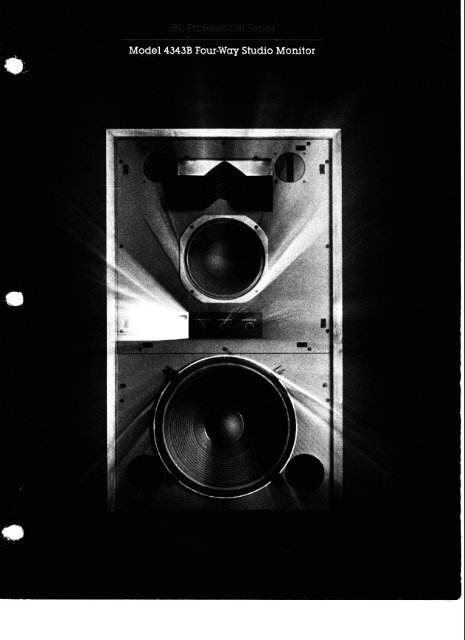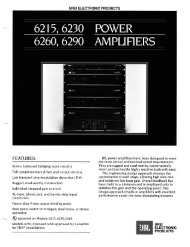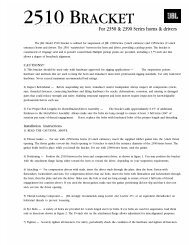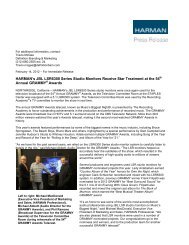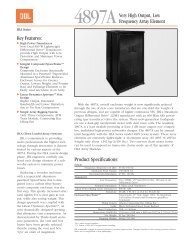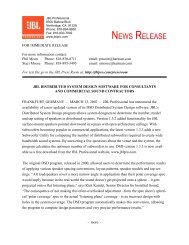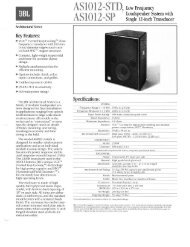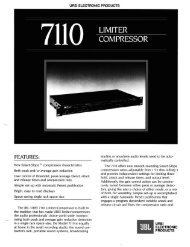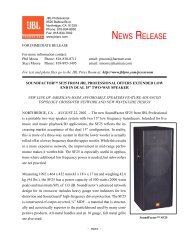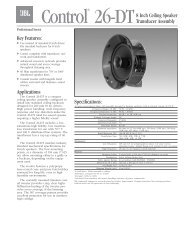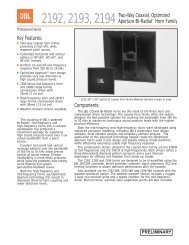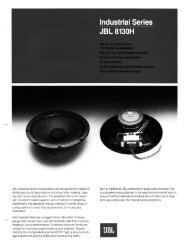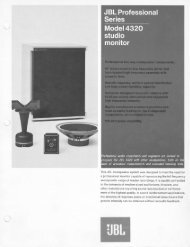4343B - JBL Professional
4343B - JBL Professional
4343B - JBL Professional
You also want an ePaper? Increase the reach of your titles
YUMPU automatically turns print PDFs into web optimized ePapers that Google loves.
AC-ate,<br />
*3dB<br />
94dBSPL,lW,lm<br />
smooth reproduction from 35 to 20,000 Hz,<br />
102 dB SPL at 10 feet at one-half rated power input<br />
Mountable in vertical or horizontal orientation<br />
Components: 380 mm (15 in) low frequency<br />
loudspeaker, 250 mm (10 in) midrange loudspeaker,<br />
high frequency compression driver with horn/lens<br />
assembly and ultra-high frequency transducer<br />
Balance controls located behind the removable grille<br />
Rear mounted switch for bi-amplificatfon or full<br />
passive crossover<br />
Oiled wulnut or textured gray enclosure<br />
The <strong>4343B</strong> Studfo Monitor<br />
The <strong>4343B</strong> represents an extension of the research and<br />
development effort that produced the 4350 Studio<br />
Monitor, <strong>JBL</strong>’s top system, which uses dual low<br />
frequency drivers. This new monitor accurately<br />
reproduces the full range of fundamentals and<br />
overtones m music at sound pressure levels<br />
approximating those of an onginal performance.<br />
The exceptionally smooth urlde-band reproduction.<br />
clarity, transient response and low distortion of the<br />
<strong>4343B</strong> results from total integration of the components<br />
that make up the four-way system so that each<br />
transducer reproduces only that portion of the audio<br />
spectrum for which it is specifically designed.<br />
Deliberately restncting the operating bandwidth of the<br />
individual drivers results in maximization of each<br />
unit’s transient response. Another benefit of bandwidth<br />
limitation is that each driver operates only in the<br />
region of the audio spectrum through which ft exhibits<br />
controlled sound distribution. thus a dispersion<br />
pattern for the complete system is achieved which is<br />
ideal for studio use The passfve frequency divlding<br />
network supplied with the <strong>4343B</strong> controls the acoustic<br />
output of all the mdivldual transducers, and may be<br />
switched for bi-amplification<br />
Low Frequency Loudspeaker<br />
Mfdrange Loudspeaker<br />
The smooth performance and instantaneous transient<br />
response of the 250 mm (10 in) midrange loudspeaker is 2<br />
largely responsible for the outstanding instrumental<br />
clarity vocal definition and dimensional accuracy of<br />
the system. The magnetic assembly, weighing 4.7 kg<br />
(10% lb), utilizes <strong>JBL</strong>’s SFG design to reduce second<br />
harmonic distortion. The 75 mm (3 in) edgewound<br />
copper ribbon voice coil is suspended within a powerful<br />
magnetic field havfng a flux density of 1.02 T (10,200<br />
gauss). The integrally stiffened cone is terminated with<br />
an exclusive <strong>JBL</strong> ring compliance that allows long<br />
excursions while maintaining linear travel.<br />
High Frequency Compression Drfver<br />
The high frequency compression driver provides<br />
smooth, accurate response and is capable of<br />
delivering the high power output levels required in<br />
monitor applications. The closed magnetic assembly<br />
is energized by an Alnico V magnet, weighs 4.5 kg<br />
(10 lb) and achieves a flux density of 1.9 T (19,000 gauss)<br />
in the voice coil gap. A ring of pure silver deposited on<br />
the circumference of the pole piece maintains uniform<br />
impedance through the highest frequencies, extending<br />
the bandwidth of the driver. The diaphragm,<br />
pneumatically formed of 0.05 mm (0.002 in) aluminum<br />
foil stock, is driven by a 44 mm (1.75 in) edgewound<br />
aluminum ribbon voice coil. The wavefront emerging<br />
from the diaphragm is directed through the concentric<br />
channels of a phasing plug prior to distribution by the<br />
horn/lens assembly<br />
Horn/Lens Assembly 4<br />
Output from the high frequency compression driver<br />
is distributed through a controlled pattern by the<br />
horn/lens assembly The horn fs formed of a rigid<br />
casting to eliminate spurious resonance. The<br />
exponential taper rate of the horn controls the<br />
expansion of the wavefront providing proper acoustic<br />
loading of the driver diaphragm and determines the<br />
vertical dispersion pattern of the assembly The<br />
The 380 mm (15 in) low frequency loudspeaker is<br />
mounted in a ported enclosure having an internal<br />
volume of 156 litres (5.5 ft3). The driver features<br />
extreme, solid low frequency reproduction with<br />
smooth response well past its crossover frequency The<br />
unit is energized by an 8.5 kg (18% lb) magnetic<br />
assembly incorporating <strong>JBL</strong>’s unique Symmetrical Field<br />
Geometry (SFG), a design which reduces second harmonic<br />
distortion to inconsequential levels. The assembly<br />
concentrates a magnetic field having a flux density of<br />
1.2 T (12,000 gauss) in the voice coil gap. The 100 mm<br />
(4 in) edgewound copper ribbon voice coil is hand<br />
wound on a heat resistant support The support is<br />
affixed to a rigid cone having optimum mass, density<br />
and rigidity for exceptional transient response and<br />
maximum efficiency with the bandwidth of the driver.
^<br />
\L,<br />
L<br />
acoustic lens functions in a manner analogous to a<br />
divergent optical lens. Its 11 plates, set at a precise<br />
angle to the enclosure baffle panel. provide controlled<br />
propagation of high frequency acoustic energy in the<br />
horizontal plane.<br />
Ultra-High Frequency ‘Transducer<br />
Overtones above 9000 Hz are reproduced by a<br />
compression driver and diffraction horn specifically<br />
designed for reproduction and dispersion of energy at<br />
the extreme high end of the audio spectrum. The<br />
compression driver consists of a 1.5 kg (3.25 lb)<br />
magnetic assembly energized by an Alnico V magnet.<br />
The 44 mm (1.75 in) edgewound aluminum ribbon<br />
voice coil, suspended within a field having a flux<br />
density of 1.65 T (16,500 gauss) is affixed to a heat<br />
resistant support bonded to a ring diaphragm<br />
pneumatically formed of 0.006 mm (0.0022 in)<br />
aluminum foil. Output from the diaphragm is directed<br />
through the integral diffraction horn, which produces<br />
the unit’s wide high frequency dispersion pattern.<br />
Frequency Dividing Network<br />
The <strong>4343B</strong> is provided with a high level, passive<br />
frequency dividing network for the three transitions<br />
of the system The network is fitted with a rearmounted<br />
switch and separate input terminals for<br />
bi-amplification The circuitry has been designed<br />
urlth consideration for the various performance<br />
characteristics of the drivers and their location on<br />
the enclosure baffle panel. The network has been<br />
designed for continuous high power application.<br />
capacitors are non-mductive. non-polarized types<br />
urlth high AC current capacity and special inductors<br />
are used to minimize power losses within the network.<br />
Each inductor is calibrated on a sensitive electronic<br />
bridge and its value set precisely<br />
A special circuit card providing the precise cross<br />
over characteristics for bi-amplification of the <strong>4343B</strong> is<br />
available for use in the <strong>JBL</strong> 5233 or 5234 Electronic<br />
Frequency Dividing Network Conventional electronic<br />
networks can be used, but they may not have the exact<br />
frequency and filter slope characteristics required for<br />
optimum performance of the system.<br />
midrange loudspeaken for optimum bass response<br />
and to control cone excursion. thus minimizing<br />
distortion and maximizing power handling capacity of<br />
the drivers To eliminate resonance, the enclosure is<br />
constructed of dense 19 mm (0 75 in) and 25 mm (1 in)<br />
stock with a 15.~1~ baffle panel, all ]oints are carefully<br />
interlocked and glued, the back, side, top and bottom<br />
panels are lined with acoustic damping material and<br />
are each stiffened by multiple braces glued and<br />
screwed to the panel and to the adlacent surfaces of<br />
the enclosure The baffle section which supports the<br />
midrange, high frequency and ultra-high frequency<br />
transducers may be rotated 90’ left or right for<br />
horizontal system installations<br />
Test Parameters<br />
The accompanying graph and specifications were<br />
compiled from measurements made under standard<br />
laboratory test conditionsThe complete loudspeaker<br />
system, including the enclosure, was mounted flush<br />
in the center of a large, flat baffle in an anechoic<br />
environment. Calibrated condenser microphones<br />
were suspended at a measured distance from the<br />
sound source, sufficiently out of the near field. All<br />
associated electronic equipment was checked and<br />
calibrated before tests were run.<br />
Response<br />
Frequency response of the 43436 taken wth %-octave band pmk<br />
nowe Measured response contour of a typlcal system averaged<br />
through an mcluswe arcof 60° in the honzontal and 30° m the vertical<br />
planes does not dewate more than 2 df3 from the above curve<br />
In keeping with current trends in studio design that<br />
encourage creativity <strong>JBL</strong> studio monitor enclosures<br />
feature contemporary styling and are offered in two<br />
finishes, each with a complementary grille color. The<br />
enclosure, however, contributes much more than<br />
striking appearance.The low frequency loudspeaker<br />
is housed in a chamber having an internal volume<br />
of 156 litres (5.5 ft3). The midrange loudspeaker is<br />
enclosed in a separate, isolated sub-chamber having<br />
an internal volume of 14 litres (0.5 ft3). The internal<br />
volume of the acoustic chambers and physical<br />
configuration of the ducted ports are carefully<br />
calibrated to properly load the low frequency and
specincations<br />
Maximum Power Input’<br />
Bi-amplification<br />
Below 300 Hz<br />
Above 300 Hz<br />
Single amplification<br />
Nominal Impedance<br />
Power Output2<br />
Frequency<br />
Response<br />
Sine Wave, On-Axis<br />
‘%-Octave Band<br />
(400 Hz Reference)<br />
Polar Response<br />
Sensitivity3<br />
Distortion<br />
% Power, 100 dB<br />
SPV3.0 m (10 ft),<br />
Single Frequency<br />
75 W continuous sine wave<br />
75 W continuous sine wave<br />
75 Wcontinuous sine wave<br />
8rl<br />
102 dB SPL measured at 3 0 m (10 ft)<br />
in a room volume of 57 m3 (2000ft3)<br />
with % rated power input<br />
35 to 20,000 Hz +3 dB<br />
-4 dB at 31.5 Hz,<br />
+2 dB at 1 kHz,<br />
+2 dB at 20 kHz<br />
No less than -3 dB at 60° horizontal<br />
and 30° vertical to 16 kHz<br />
94 dB SPL measured at 1 m (3.3 ft)<br />
with l-watt input averaged from<br />
100 to 1000 Hz<br />
1% or less third harmonic generation<br />
from 35 to 800 Hz<br />
2% or less third harmonic generation<br />
above 800 Hz<br />
Crossover Frequencies4 300,125O and 9500 Hz<br />
Finish<br />
Grille<br />
Enclosure Volume<br />
Low Frequency<br />
Chamber<br />
Midrange Chamber<br />
Enclosure Dimensions<br />
Net Weight<br />
Shipping Weight<br />
Accessories<br />
(for bi-amplification)<br />
-<br />
Textured gray or oiled walnut<br />
Black fabric with the gray finish;<br />
Dark blue fabric with walnut<br />
156 L 5.5ft=<br />
14 L 0.5 ft3<br />
1050 mmx635 mmx435 mm<br />
41% inx25 inxl7X in<br />
84 kg 185lb<br />
92 kg 202 lb<br />
5233 Electronic Frequency Dividing<br />
Network, single channel; 5234 Electronic<br />
Frequency Dividing Network,<br />
dual channel; 52-5140CrossoverCard,<br />
required for the low frequency<br />
transition of the 43438.<br />
Caution Sound pressure levels produced by the 43438 may cause<br />
permanent heanng loss Thesuggested maxlmumexposureis 115dBA<br />
for no more than 15 mmutes (Department of Labor Bullebn #334)<br />
<strong>JBL</strong> continually engages m research related to product Improvement d<br />
New materials.. production methods and design refinements are Introduced<br />
Into exlstlng products without notlce as a routme expressIon of<br />
that philosophy For this reason, any current <strong>JBL</strong> product may differ<br />
I” some respect from Its publlshed descnption but will always equal<br />
or exceed the ongmal design specifications unless otherwlse stated<br />
‘Power amplifier headroom recommendation is 3 dB mimmum, i e , for<br />
a 75-watt rating use a 150-watt amplifier<br />
*Power output measured with a B&K Impulse Precision Sound Level<br />
Meter.<br />
%nlike many”theater type” loudspeaker systems that exhlblt sensetivity<br />
peaks in the mldrange region, the 43438 provides substantially<br />
the same sensitivity through the full range of audible frequencies.<br />
Measured sensitivity below 500 Hz or above 2ChXI Hz may be considerably<br />
greater than that of other systems with higher sensitivity ratings<br />
‘The 52-5140 crossover card installed in a <strong>JBL</strong> electronic frequency<br />
dividing network will provide the appropriate crossover characteristics<br />
for bi-amplification If another electronic network IS used. a<br />
12 dB/octavefllter slope will provide the closest approximation of the<br />
52-5140<br />
<strong>Professional</strong> Division<br />
James B. Lansing Sound, Inc.,<br />
8500 Balboa Boulevard,<br />
Northridge, California 91329 U.S.A.<br />
5543438 2,sc PRINTED IN U.S.A.


